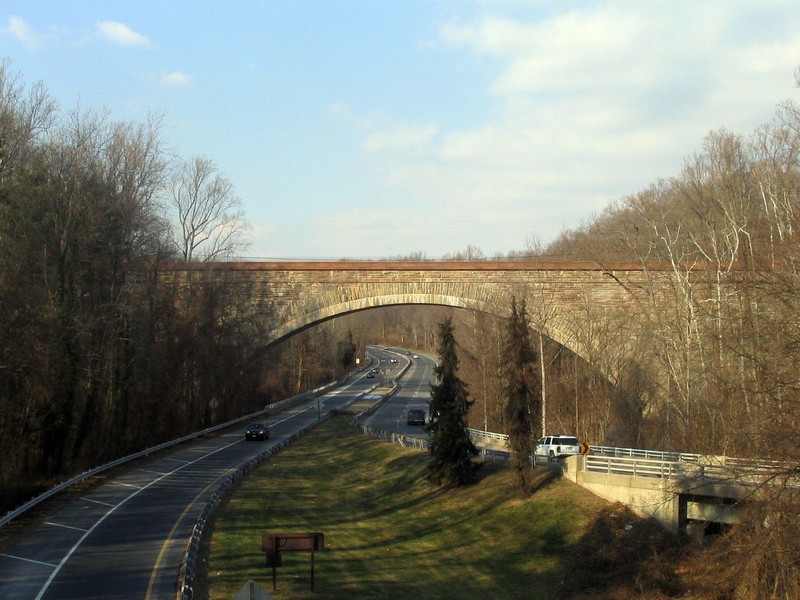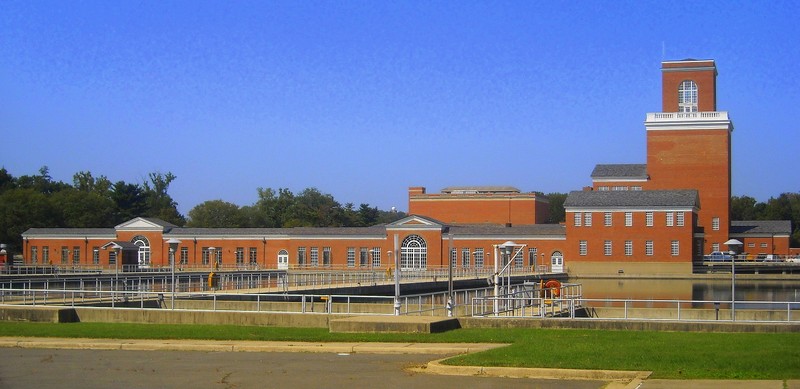Washington Aqueduct
Introduction
Text-to-speech Audio
The Washington Aqueduct in an aqueduct that provides the public water supply system serving Washington, D.C., and parts of its suburbs. One of the first major aqueduct projects in the United States, the Aqueduct was commissioned by Congress in 1852. The construction began in 1853 under the supervision of Montgomery C. Meigs and the US Army Corps of Engineers which still owns and operates the system. Portions of the Aqueduct went online on January 3, 1859, and full pipeline begain operating in 1864. The system has been in continuous use ever since.
Images
The union arch bridge carries the Washington Aqueduct across Cabin John Creek

Dalecarlia Water Treatment Plant

Backstory and Context
Text-to-speech Audio
The centerpiece of the Aqueduct is a 12 mile pipeline which connects the systems damn at Great Falls with Dalecarlia Reservoir on the border with Montgomery County, Maryland. The pipeline runs along what is now MacArthur Boulevard, traversing some of the higher cliffs along the Potomac River. The Union Arch Bridge carries the pipeline and MacArthur Boulevard over cabin John Creek and the Cabin John Parkway near the community of cabin John, Maryland. This bridge was the longest masonry bridge in the world for 40 years after its completion. This is listed as a National Historic Landmark, and the Union Arch Bridge within the system is listed as Historic Civil Engineering Landmark.
The Dalecarlia Reservoir serves as a primary sedimentation basin. A portion of the water from the reservoir is treated as the nearby Dalecarlia Water Treatment Plant and distributed to municipal water mains. The remainder of the water from the reservoir flows to the Georgetown Reservoir in Georgetown. This facility serves as an additional sedimentation basin. The water flows through the Washington City Tunnell to the treatment facility at the McMillan Reservoir, after which it is pumped through the city mains.
The system originally used a single pipe for water delivery, and did not have any water purification plants, relying instead on the reservoirs to act as settling basins. By the turn of the 20th century, however, Washington's growth and the high amount of sediment in the Potomac's water kept the reservoirs from doing their jobs well, and so the first treatment plant, a massive slow sand filter bed system, was installed at McMillian Reservoir, and was completed in 1905. The regular use of chlorine as a disinfectant began in 1923 at the McMillan plant. The McMillan plant was not replaced until 1985, when a rapid sand filter plant was opened adjacent to it. Efforts are under way to redevelop the land the slow sand plant used, while maintaining some of the plant's sand silos for historical purposes.
In the 1920s, the Aqueduct was upgraded with the addition of a second pipe from Great Falls to Dalecarlia, along with several new reservoirs and a pumping station. This is a rapid sand filter plant that was built at Dalecarlia Reservoir, which went online in 1927. The Dalecarlia plant is the larger of the two plants in the system, having been upgraded in the 1950s, and is the plant that serves the Virginia communities that use the Aqueduct. The Corps built an additional intale and pumping station at Little Falls in 1959.
The Dalecarlia Reservoir serves as a primary sedimentation basin. A portion of the water from the reservoir is treated as the nearby Dalecarlia Water Treatment Plant and distributed to municipal water mains. The remainder of the water from the reservoir flows to the Georgetown Reservoir in Georgetown. This facility serves as an additional sedimentation basin. The water flows through the Washington City Tunnell to the treatment facility at the McMillan Reservoir, after which it is pumped through the city mains.
The system originally used a single pipe for water delivery, and did not have any water purification plants, relying instead on the reservoirs to act as settling basins. By the turn of the 20th century, however, Washington's growth and the high amount of sediment in the Potomac's water kept the reservoirs from doing their jobs well, and so the first treatment plant, a massive slow sand filter bed system, was installed at McMillian Reservoir, and was completed in 1905. The regular use of chlorine as a disinfectant began in 1923 at the McMillan plant. The McMillan plant was not replaced until 1985, when a rapid sand filter plant was opened adjacent to it. Efforts are under way to redevelop the land the slow sand plant used, while maintaining some of the plant's sand silos for historical purposes.
In the 1920s, the Aqueduct was upgraded with the addition of a second pipe from Great Falls to Dalecarlia, along with several new reservoirs and a pumping station. This is a rapid sand filter plant that was built at Dalecarlia Reservoir, which went online in 1927. The Dalecarlia plant is the larger of the two plants in the system, having been upgraded in the 1950s, and is the plant that serves the Virginia communities that use the Aqueduct. The Corps built an additional intale and pumping station at Little Falls in 1959.
Sources
http://www.dcwater.com/about/cip/aqueduct.cfm
http://www.nps.gov/choh/historyculture/thewashingtonaqueductsystem.htm
